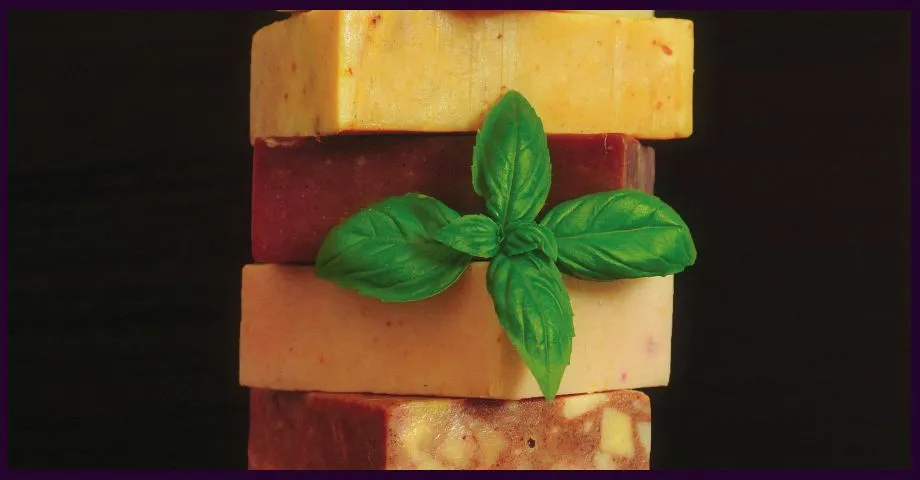In this comprehensive guide, we’ll delve into the art of crafting your very own handmade vegan soap bars, unlocking the secrets to a truly indulgent yet sustainable self-care routine. From understanding the essential ingredients to mastering the techniques, you’ll gain the knowledge and confidence to create beautiful, handcrafted soaps that not only pamper your skin but also align with your values.
The Allure of Homemade Vegan Soap
Homemade vegan soap offers a multitude of benefits that extend far beyond just cleansing your skin. By taking the time to craft your own bars, you gain complete control over the ingredients, ensuring that each component is ethically sourced and free from animal-derived products or harsh chemicals.
Moreover, handmade vegan soap is often gentler on the skin, as you can tailor the formula to your specific needs, avoiding potential irritants found in many commercial soap products. The natural oils and glycerin that remain in the final product contribute to a luxuriously moisturizing and nourishing experience, leaving your skin feeling soft, supple, and radiant.
The Building Blocks: Essential Ingredients
Before we dive into the soap-making process, let’s explore the essential ingredients that will form the backbone of your vegan soap creations:
- Plant-Based Oils: Olive oil, coconut oil, and sustainable palm oil are popular choices for vegan soap making, each offering unique properties and benefits for your skin.
- Lye (Sodium Hydroxide): While the word “lye” may sound intimidating, it is a crucial ingredient in soap making, as it facilitates the chemical reaction that transforms oils into soap.
- Distilled Water: Using distilled water ensures that no impurities or minerals interfere with the soap-making process.
- Essential Oils or Natural Fragrance Oils (Optional): These aromatic oils can add a delightful scent to your soap bars, enhancing the sensory experience.
- Natural Colorants (Optional): From vibrant clays to botanical powders, natural colorants can add a pop of color and visual appeal to your soap bars.
Safety First: Handling Lye Responsibly
While lye is an essential component of soap making, it is a caustic substance that requires proper precautions and handling. Always wear protective equipment, such as gloves and goggles, when working with lye, and ensure adequate ventilation.
It’s crucial to use a lye calculator to determine the precise amount of lye needed for your specific oil blend. Too little lye will result in an unsuccessful batch of soap, while too much can produce a harsh, lye-heavy soap that can be damaging to the skin.
The Art of Cold Process Soap Making
One of the most popular methods for creating homemade vegan soap is the cold process technique. This traditional method involves combining the lye solution and oils, allowing them to undergo a chemical reaction known as saponification, transforming the ingredients into soap.
The “cold process” refers to the fact that the soap batter is not cooked or heated during the process, allowing the natural glycerin to remain in the soap, resulting in a luxuriously moisturizing bar.

Photo by Sincerely Media on Unsplash
Here’s a step-by-step guide to creating your very own batch of handmade vegan cold process soap:
- Prepare your workspace and gather all the necessary equipment and ingredients.
- Using a lye calculator, determine the amount of lye needed for your chosen oil blend.
- Carefully mix the lye and distilled water, stirring until the lye is fully dissolved.
- Weigh and melt your plant-based oils.
- Once the lye solution and oils have cooled to the appropriate temperatures, slowly pour the lye solution into the oils, stirring constantly.
- Continue stirring until the mixture reaches “trace,” a thick, pudding-like consistency.
- At this point, you can add any desired essential oils, natural colorants, or additives.
- Pour the soap batter into your prepared mold and insulate it to maintain the heat from the saponification process.
- Allow the soap to sit for 24-48 hours before removing it from the mold.
- Cut the soap into bars and allow it to cure for 4-6 weeks before use.
The Importance of Curing Your Soap
While it may be tempting to use your freshly made soap right away, it’s essential to allow your bars to cure for 4-6 weeks. During this curing process, the soap continues to saponify and harden, resulting in a longer-lasting, milder bar of soap.
Proper curing also ensures that any excess water evaporates, leaving you with a firm, long-lasting soap bar that will provide a luxurious lather and nourishing experience for your skin.
Frequently Asked Questions About Vegan Soap Making
Throughout your soap-making journey, you may have a few questions or concerns. Here are some of the most frequently asked questions about vegan soap making:
- Can I substitute the olive oil for another oil? Absolutely! While olive oil is a popular choice, you can experiment with a variety of plant-based oils, such as coconut, sunflower, or avocado oil, to create unique soap formulas.
- How long does handmade soap last? Properly cured and stored, handmade vegan soap can last for several months to a year, depending on the ingredients and formulation.
- Is it possible to make vegan soap without lye? No, lye is an essential ingredient in soap making, as it facilitates the chemical reaction that transforms oils into soap. However, when used correctly and in the right proportions, the lye is fully consumed during the saponification process, leaving no unreacted lye in the final product.
- Can I use essential oils in my soap? Absolutely! Essential oils can add a delightful aroma to your soap bars, as well as potential therapeutic benefits. Just be sure to use high-quality, pure essential oils and follow recommended usage rates.
Summary: Key Points to Remember
- Homemade vegan soap offers a luxurious, cruelty-free, and eco-friendly alternative to commercial soap products.
- Essential ingredients include plant-based oils, lye, distilled water, and optional additives like essential oils and natural colorants.
- Safety measures, such as wearing protective equipment and handling lye with care, are crucial in soap making.
- The cold process method involves combining the lye solution and oils, allowing them to undergo saponification to create soap.
- Customizing your soap with different oil blends, additives, and essential oils allows for endless creativity.
- Proper curing is essential for a long-lasting, mild soap bar.
- Packaging and gifting your handmade vegan soap can be a creative and eco-friendly endeavor.
- Don’t be afraid to troubleshoot and learn from any issues that arise during the soap-making process.
Embrace the art of homemade vegan soap making, and experience the joy of creating a luxurious, sustainable self-care ritual that nourishes your skin and aligns with your values. Happy soap making!
featured Photo by Viktor Forgacs on Unsplash
This article is written by:

The Hobbyist's Roadmap
Introducing the writers team at The Hobbyist's Roadmap! We're a group of passionate individuals with diverse skills, united in our goal to inspire and support hobbyists. From gardening to crafting, cooking to photography, we're here to provide valuable insights and tips to fuel your interests. Join us as we embark on this journey together! Welcome to The Hobbyist's Roadmap.




